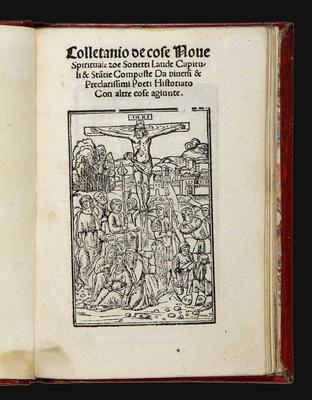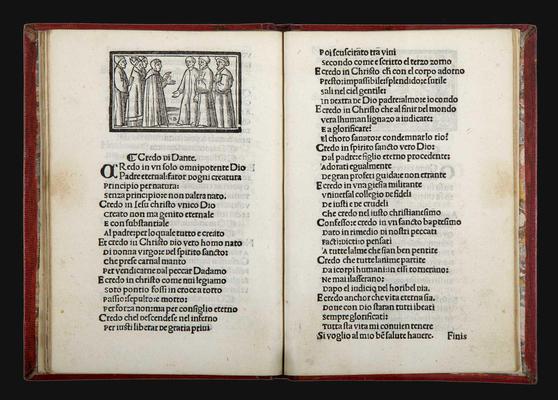Dante Alighieri
Credo di Dante (included in:) Colletanio de cose Nove Spirituali zoe de Sonetti, Laude, Capituli & Stantie Composte Da diversi & preclarissimi Poeti.
Venice, Niccolò Zoppino and Vincenzo di Paolo, 15 July 1521.8° (152x103 mm). Collation: A-F8. [48] leaves. Gothic and roman type. On fol. F8r large woodcut printer's device. On the title-page woodcut depicting the Crucifixion, one full-page woodcut on fol. A1v, twenty-three woodcut vignettes in text. Twentieth-century red half-morocco, boards covered by red paper. Smooth spine, divided in compartments with gilt fillets, title and imprint in gilt lettering. Marbled pastedowns and flyleaves. A very good copy. Light stain in the gutter of the first leaves. A contemporary hand has added on the margins the names of the authors of the anonymous poems which are included in the volume.
Provenance: Livio Ambrogio collection.
The exceedingly rare early edition of the vernacular religious collection first published by the Venetian printer Niccolò Zoppino in 1509. The anthology also includes the apocryphal poem in terzine entitled the Credo, a substantial paraphrase of the Apostle's Creed. The tradition says that Dante composed the Credo to defend himself from the accusation of heresy, with which the ecclesiastical authorities in Ravenna had charged him, on the grounds that the Commedia included numerous doctrinal errors. The legend of ‘Dante as heretic' rapidly spread after his death, with the story of his encounter with a Franciscan inquisitor in a Ravenna church being found in numerous manuscripts: the friar is supposed to have declared that Dante would have done better to write his poem in Latin, basing it on the teachings of the Holy Church.
Even though most of the approximately forty manuscripts which include the text, as well as the printed editions which appeared in the fifteenth and sixteenth centuries, name Dante as the author of the Credo, scholars have more recently attributed it to ‘Maestro' Antonio da Ferrara, i.e. the fourteenth-century poet Antonio Beccari, who composed poems stylistically close to the Credo, and containing many references to Dante and his works. The Credo di Dante appeared for the first time in print in Jesi, between 1472 and 1475. The unique copy of this edition – bearing the title of Credo che Dante fece quando fu accusato per eretico all'inquistore – is today in the Biblioteca Nazionale in Florence. There are at least thirteen separate editions of the work published before about 1530, all of them of great rarity. The text was also included in the Venetian edition of the Commedia printed in 1477 by Vindelinus de Speyer, the first to include other spurious works ascribed at the time to Dante: in addition to the Credo, the vernacular translations of the Ave Maria, the Pater noster and the Septem Psalmi Poenitentiales.
In this edition published by Zoppino, the text of the Credo is introduced by a woodcut vignette in a popular style which depicts, in all likelihood, Dante pronouncing his formal confession of faith before the ecclesiastical authorities.



